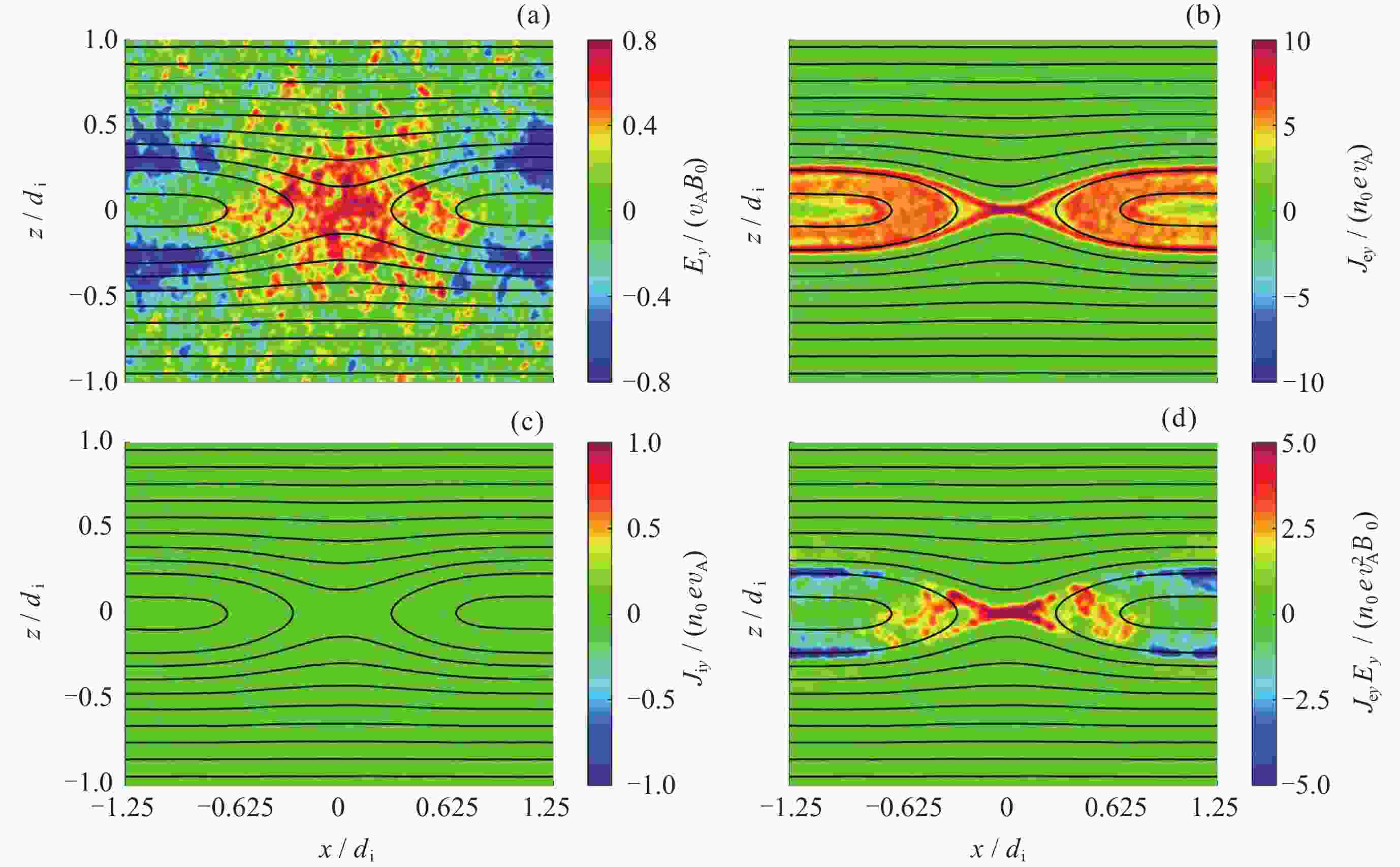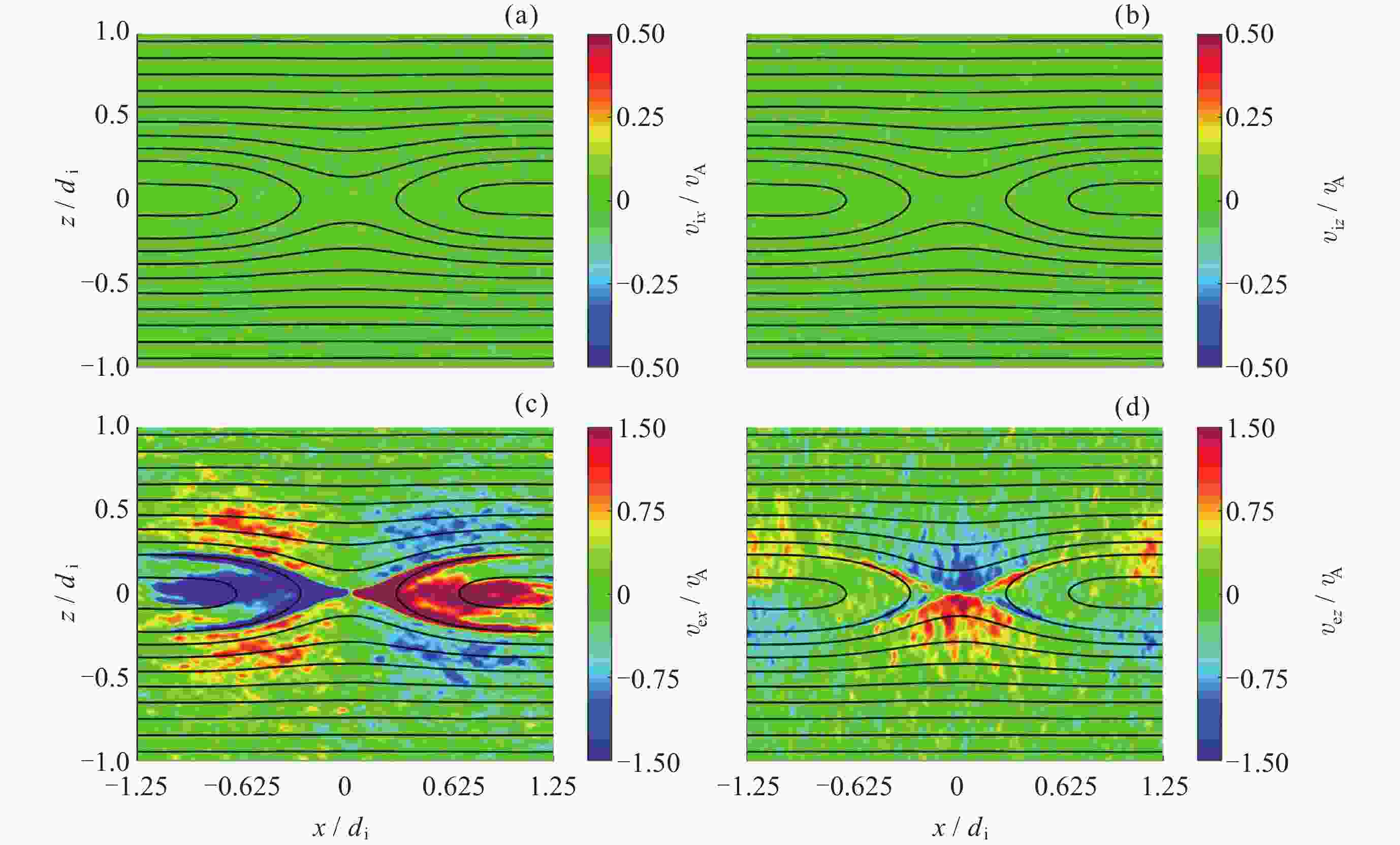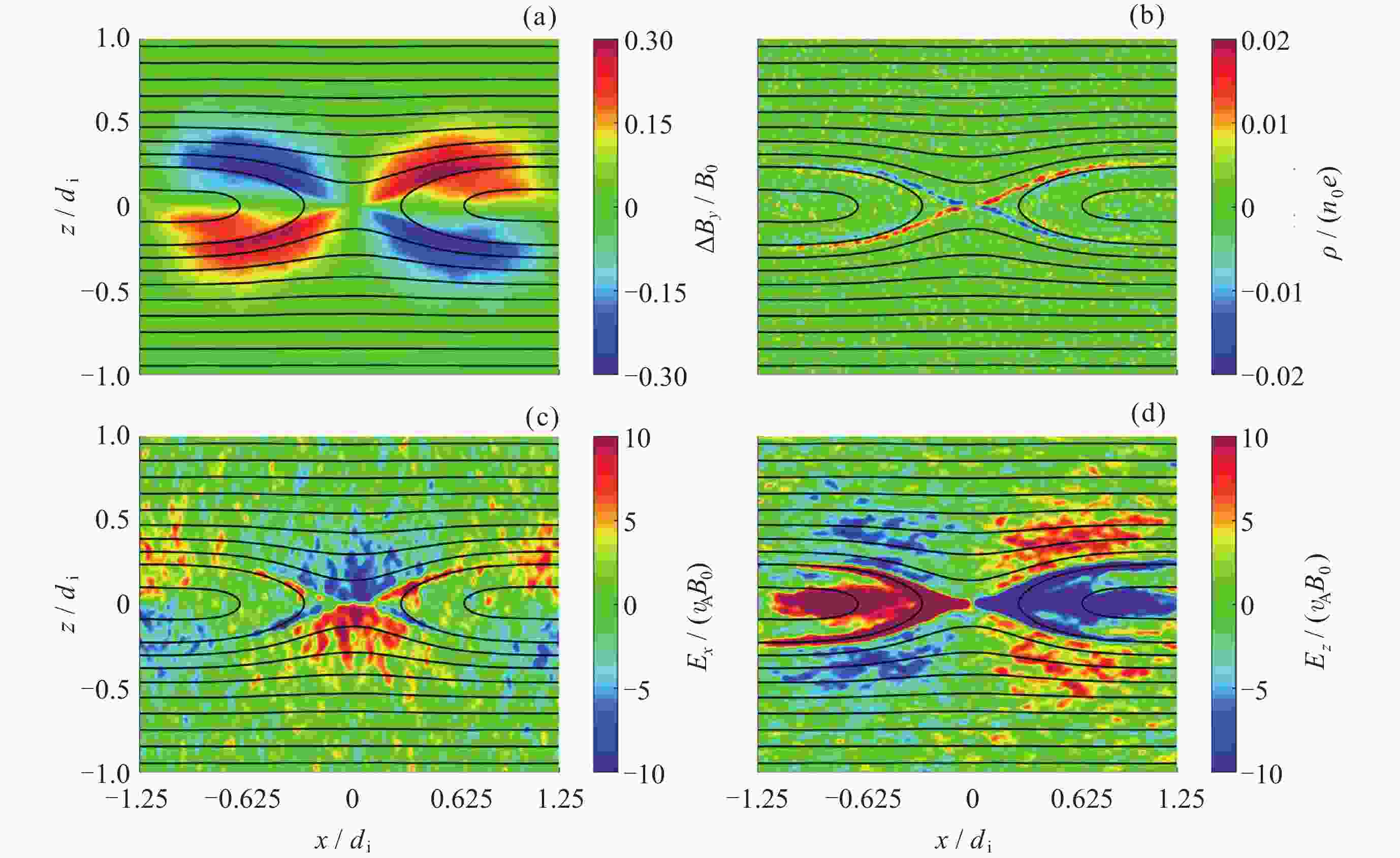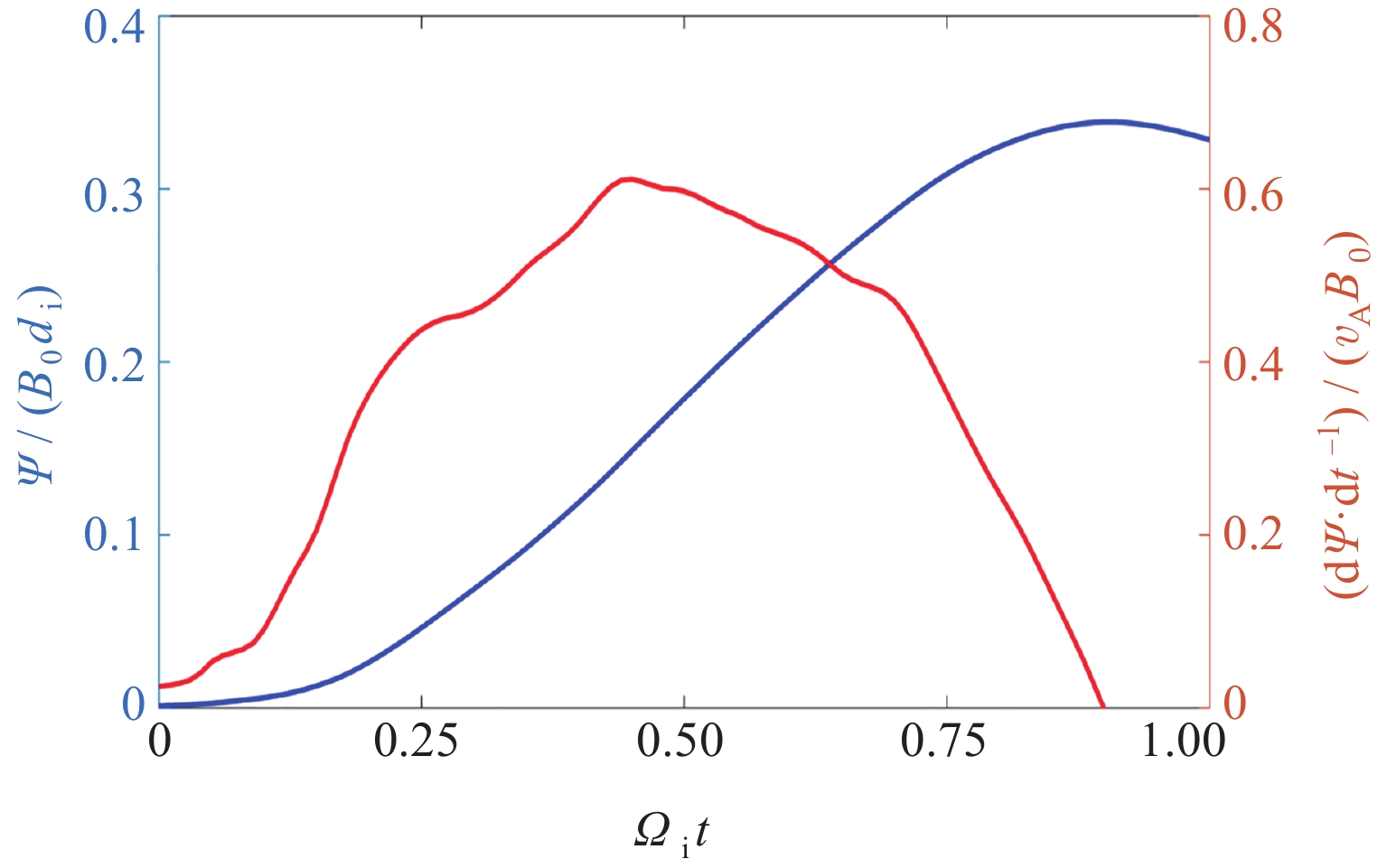Particle-in-cell Simulation of Electromagnetic Field Structure in the Electron-only Reconnection
-
摘要: 采用2.5D全粒子模拟程序研究了强引导场情况下的电子重联, 分析了重联率最大时刻霍尔磁场、霍尔电场及电子流速的空间分布特征. 重联率最大时刻, 观察到分离线两侧的电子入流及出流, 并且有四极霍尔磁场生成. 与早期标准重联的研究结果不同, 霍尔磁场并未在引导场的作用下发生明显扭曲. 同时分离线区域发生电荷分离, 并生成近似对称分布的霍尔电场. 此外, 研究了电子流速空间分布的时间演化. 在重联前期, 电子主要沿磁力线流动, 即 $ \boldsymbol{v}_{{\mathrm{e}}}\approx v_{\mathrm{e}y}\boldsymbol{B}/B_y $; 在重联后期, 电子运动由电场漂移所主导, 即 $ \boldsymbol{v}_{{\mathrm{e}}}\approx\boldsymbol{E}\times\left(B_y\boldsymbol{e}_{{{y}}}\right)/B_y^2 $. 模拟结果表明, 电子重联中可以发生极强的电荷分离, 生成近似对称分布的霍尔电场. 在引导场下, 这种霍尔电场将导致电子的电场漂移, 并主导电子流速的面内空间分布, 进而生成近似对称分布的霍尔电流和四极霍尔磁场.Abstract: Standard collisionless magnetic reconnection couples with both electron and ion dynamics. Recently, a new type of magnetic reconnection, electron-only magnetic reconnection without ion outflow, has been observed. Using $ 2.5 $D particle-in-cell simulation, the electromagnetic field structure in the electron-only reconnection with a strong guide field was studied. At the moment of the maximum reconnection rate, the electron inflow and outflow are observed on either side of the separatrix. The spatial distribution of the electron bulk velocity is approximately symmetric, which generates the nearly symmetrically distributed Hall current, resulting in the quadrupole Hall magnetic field. The Hall magnetic field is not obviously distorted despite the presence of the strong guide field. Meanwhile, the charge separation is caused in the separatrix region, which generates the nearly symmetrically distributed Hall electric field. Besides, the evolution of the spatial distribution of the electron bulk velocity was studied. The equation of motion for the frozen electrons was analytically obtained: $ \boldsymbol{v}_{\rm{{e}}}=v_{\mathrm{e}y}\boldsymbol{B}/B_y+\boldsymbol{E}\times\left(B_y\boldsymbol{e}_{{{y}}}\right)/B_y^2 $. According to the equation of motion for the electrons, we divide the electron-only reconnection with a strong guide field into two stages. In the first stage, the $ \boldsymbol{E}\times \boldsymbol{B} $ drift is negligible because of the weaker Hall electric field, and then the electrons flow mainly along the magnetic field line following the equation $ \boldsymbol{v}_{\rm{{e}}}\approx v_{\mathrm{e}y}\boldsymbol{B}/B_y $. In the second stage, the Hall electric field is so strong that the motion of electrons is dominated by the $ \boldsymbol{E}\times \boldsymbol{B} $ drift following the equation $ \boldsymbol{v}_{\rm{{e}}}\approx\boldsymbol{E}\times\left(B_y\boldsymbol{e}_{{{{y}}}}\right)/B_y^2 $. The simulation shows that extremely strong charge separation can be caused in electron-only reconnection, which generates the nearly symmetrically distributed Hall electric field. With a guide field, this Hall electric field leads to the $ \boldsymbol{E}\times \boldsymbol{B} $ drift, which dominates the spatial distribution of the electron bulk velocity. Therefore nearly symmetrically distributed Hall current is formed, which generates the nearly symmetrically distributed quadrupole Hall magnetic field.
-
图 2 $ {\varOmega }_{\mathrm{i}}t=0.45 $时刻面外重联电场$ {E}_{y} $, 电子面外电流$ {J}_{\mathrm{e}y} $, 离子面外电流$ {J}_{\mathrm{i}y} $和$ {J}_{\mathrm{e}y}{E}_{y} $面内空间分布 (黑色实线表示磁力线)
Figure 2. Color contours of the reconnection electric field $ {E}_{y}$, the out-of-plane current of electrons $ {J}_{\mathrm{e}y} $, the out-of-plane current of ions $ {J}_{\mathrm{i}y} $, and $ {J}_{\mathrm{e}y}{E}_{y} $ at $ {\varOmega }_{\mathrm{i}}t=0.45 $ (The black lines represent the magnetic field lines)
图 3 $ {\varOmega }_{\mathrm{i}}t=0.45 $时刻$ x $方向离子流速$ {v}_{\mathrm{i}x} $, $ z $方向离子流速$ {v}_{\mathrm{i}z} $, $ x $方向电子流速$ {v}_{\mathrm{e}x} $和$ z $方向电子流速$ {v}_{\mathrm{e}z} $的面内空间分布(黑色实线表示磁力线)
Figure 3. Color contours of the ion bulk velocity in the $ x $ direction $ {v}_{\mathrm{i}x} $, the ion bulk velocity in the $ z $ direction $ {v}_{\mathrm{i}z} $, the electron bulk velocity in the $ x $ direction $ {v}_{\mathrm{e}x} $, and the electron bulk velocity in the $ z $ direction $ {v}_{\mathrm{e}z} $ at $ {\varOmega }_{\mathrm{i}}t=0.45 $ (The black lines represent the magnetic field lines)
图 4 $ {\varOmega }_{\mathrm{i}}t=0.45 $时刻霍尔磁场$ {\Delta }{B}_{y}={B}_{y}-{B}_{\mathrm{g}} $, 电荷密度$ \rho $, 面内电场$ {E}_{x} $和面内电场$ {E}_{z} $的面内空间分布 (黑色实线表示磁力线)
Figure 4. Color contours of the Hall magnetic field $ {\Delta }{B}_{y}={B}_{y}-{B}_{\mathrm{g}} $, the charge density $ \rho $, the electric field $ {E}_{x} $, and the electric field $ {E}_{z} $ at $ {\varOmega }_{\mathrm{i}}t=0.45 $ (The black lines represent the magnetic field lines)
图 5 $ {\varOmega }_{\mathrm{i}}t=0.10 $和$ {\varOmega }_{\mathrm{i}}t=0.45 $时刻$ x $方向电子流速$ {v}_{\mathrm{e}x} $和$ z $方向电子流速$ {v}_{\mathrm{e}z} $的面内空间分布 (黑色实线表示磁力线)
Figure 5. Color contours of the electron bulk velocity in the $ x $ direction $ {v}_{\mathrm{e}x} $ and the electron bulk velocity in the $ z $ direction $ {v}_{\mathrm{e}z} $ at $ {\varOmega }_{\mathrm{i}}t=0.10 $ and $ {\varOmega }_{\mathrm{i}}t=0.45 $ (The black lines represent the magnetic field lines)
-
[1] VASYLIUNAS V M. Theoretical models of magnetic field line merging[J]. Reviews of Geophysics, 1975, 13(1): 303-336 doi: 10.1029/RG013i001p00303 [2] BISKAMP D. Magnetic Reconnection in Plasmas[M]. Cambridge: Cambridge University Press, 2000. DOI: 10.1017/CBO9780511599958 [3] YAMADA M, KULSRUD R, JI H T. Magnetic reconnection[J]. Reviews of Modern Physics, 2010, 82(1): 603-664. doi: 10.1103/RevModPhys.82.603 [4] 王水, 陆全明. 无碰撞磁场重联[M]. 北京: 科学出版社, 2019WANG Shui, LU Quanming. Collisionless Magnetic Reconnection[M]. Beijing: Science Press, 2019 [5] MASUDA S, KOSUGI T, HARA H, et al. A loop-top hard X-ray source in a compact solar flare as evidence for magnetic reconnection[J]. Nature, 1994, 371(6497): 495-497 doi: 10.1038/371495a0 [6] KRUCKER S, HUDSON H S, GLESENER L, et al. Measurements of the coronal acceleration region of a solar flare[J]. The Astrophysical Journal, 2010, 714(2): 1108-1119 doi: 10.1088/0004-637X/714/2/1108 [7] CASSAK P A, SHAY M A. Magnetic reconnection for coronal conditions: reconnection rates, secondary islands and onset[J]. Space Science Reviews, 2012, 172(1): 283-302 doi: 10.1007/s11214-011-9755-2 [8] SANG L L, LU Q M, XIE J L, et al. Experimental studies on the propagation of whistler-mode waves in a magnetized plasma structure with a non-uniform density[J]. Plasma Science and Technology, 2023, 25(9): 095301 doi: 10.1088/2058-6272/acc502 [9] GOSLING J T, SKOUG R M, MCCOMAS D J, et al. Direct evidence for magnetic reconnection in the solar wind near 1 AU[J]. Journal of Geophysical Research: Space Physics, 2005, 110(A1): A01107 doi: 10.1029/2004JA010809 [10] WANG R S, WANG S M, LU Q M, et al. Direct observation of turbulent magnetic reconnection in the solar wind[J]. Nature Astronomy, 2023, 7(1): 18-28 doi: 10.1038/s41550-022-01818-5 [11] WANG R S, YU X C, WANG Y M, et al. Observation of the hall magnetic reconnection as close as 56 solar Radii from the sun[J]. The Astrophysical Journal, 2023, 947(2): 78 doi: 10.3847/1538-4357/acbdf6 [12] ØIEROSET M, PHAN T D, FUJIMOTO M, et al. In situ detection of collisionless reconnection in the Earth’s magnetotail[J]. Nature, 2001, 412 (6845): 414-417. DOI: 10.1038/35086520 [13] WANG R S, LU Q M, DU A M, et al. In situ observations of a secondary magnetic island in an ion diffusion region and associated energetic electrons[J]. Physical Review Letters, 2010, 104 (17): 175003. DOI: 10.1103/PhysRevLett.104.175003 [14] ZHANG T L, LU Q M, BAUMJOHANN W, et al. Magnetic reconnection in the near Venusian magnetotail[J]. Science, 2012, 336(6081): 567-570 doi: 10.1126/science.1217013 [15] LU Q M, FU H S, WANG R S, et al. Collisionless magnetic reconnection in the magnetosphere[J]. Chinese Physics B, 2022, 31(8): 089401 doi: 10.1088/1674-1056/ac76ab [16] WANG R S, CHENG Z H, SLAVIN J A, et al. Direct detection of ongoing magnetic reconnection at mercury’s high-latitude magnetopause[J]. Geophysical Research Letters, 2024, 51(5): e2023GL106282 doi: 10.1029/2023GL106282 [17] YAMADA M, REN Y, JI H T, et al. Experimental study of two-fluid effects on magnetic reconnection in a laboratory plasma with variable collisionality[J]. Physics of Plasmas, 2006, 13(5): 052119 doi: 10.1063/1.2203950 [18] EGEDAL J, FOX W, KATZ N, et al. Laboratory observations of spontaneous magnetic reconnection[J]. Physical Review Letters, 2007, 98(1): 015003 doi: 10.1103/PhysRevLett.98.015003 [19] LI C K, SÉGUIN F H, FRENJE J A, et al. Observation of megagauss-field topology changes due to magnetic reconnection in laser-produced plasmas[J]. Physical Review Letters, 2007, 99(5): 055001 doi: 10.1103/PhysRevLett.99.055001 [20] DONG Q L, WANG S J, LU Q M, et al. Plasmoid ejection and secondary current sheet generation from magnetic reconnection in laser-plasma interaction[J]. Physical Review Letters, 2012, 108(21): 215001 doi: 10.1103/PhysRevLett.108.215001 [21] YAMADA M, YOO J, JARA-ALMONTE J, et al. Study of energy conversion and partitioning in the magnetic reconnection layer of a laboratory plasma[J]. Physics of Plasmas, 2015, 22(5): 056501 doi: 10.1063/1.4920960 [22] SANG L L, LU Q M, XIE J L, et al. Energy dissipation during magnetic reconnection in the Keda linear magnetized plasma device[J]. Physics of Plasmas, 2022, 29(10): 102108 doi: 10.1063/5.0090790 [23] MA Z W, BHATTACHARJEE A. Hall magnetohydrodynamic reconnection: the geospace environment modeling challenge[J]. Journal of Geophysical Research: Space Physics, 2001, 106(A3): 3773-3782 doi: 10.1029/1999JA001004 [24] PRITCHETT P L. Geospace Environment Modeling magnetic reconnection challenge: simulations with a full particle electromagnetic code[J]. Journal of Geophysical Research: Space Physics, 2001, 106(A3): 3783-3798 doi: 10.1029/1999JA001006 [25] HUANG C, WANG R S, LU Q M, et al. Electron density hole and quadruple structure of B y during collisionless magnetic reconnection[J]. Chinese Science Bulletin, 2010, 55(8): 718-722 doi: 10.1007/s11434-009-0538-z [26] LU Q M, HUANG C, XIE J L, et al. Features of separatrix regions in magnetic reconnection: Comparison of 2-D particle-in-cell simulations and Cluster observations[J]. Journal of Geophysical Research: Space Physics, 2010, 115(A11): A11208 doi: 10.1029/2010JA015713 [27] ZHOU M, DENG X H, ZHONG Z H, et al. Observations of an electron diffusion region in symmetric reconnection with weak guide field[J]. The Astrophysical Journal, 2019, 870(1): 34 doi: 10.3847/1538-4357/aaf16f [28] KUZNETSOVA M M, HESSE M, WINSKE D. Kinetic quasi-viscous and bulk flow inertia effects in collisionless magnetotail reconnection[J]. Journal of Geophysical Research: Space Physics, 1998, 103(A1): 199-213 doi: 10.1029/97JA02699 [29] HESSE M, SCHINDLER K, BIRN J, et al. The diffusion region in collisionless magnetic reconnection[J]. Physics of Plasmas, 1999, 6(5): 1781-1795 doi: 10.1063/1.873436 [30] EGEDAL J, GURRAM H, GREESS S, et al. The force balance of electrons during kinetic anti-parallel magnetic reconnection[J]. Physics of Plasmas, 2023, 30(6): 062106 doi: 10.1063/5.0130417 [31] BIRN J, DRAKE J F, SHAY M A, et al. Geospace Environmental Modeling (GEM) magnetic reconnection challenge[J]. Journal of Geophysical Research: Space Physics, 2001, 106(A3): 3715-3719 doi: 10.1029/1999JA900449 [32] LU Q M, WANG R S, XIE J L, et al. Electron dynamics in collisionless magnetic reconnection[J]. Chinese Science Bulletin, 2011, 56(12): 1174-1181 doi: 10.1007/s11434-011-4440-0 [33] LU S, LU Q M, CAO Y, et al. The effects of the guide field on the structures of electron density depletions in collisionless magnetic reconnection[J]. Chinese Science Bulletin, 2011, 56(1): 48-52 doi: 10.1007/s11434-010-4250-9 [34] (傅向荣, 郭俊, 王水. 存在初始引导场情况下的无碰撞磁场重联[J]. 空间科学学报, 2006, 26(6): 432-439 doi: 10.11728/cjss2006.06.432FU Xiangrong, GUO Jun, WANG Shui. Collisionless magnetic reconnection in presence of a guide field[J]. Chinese Journal of Space Science, 2006, 26(6): 432-439 doi: 10.11728/cjss2006.06.432 [35] FU X R, LU Q M, WANG S. The process of electron acceleration during collisionless magnetic reconnection[J]. Physics of Plasmas, 2006, 13(1): 012309 doi: 10.1063/1.2164808 [36] LU S, ANGELOPOULOS V, PRITCHETT P L, et al. Electrodynamic contributions to the hall- and parallel electric fields in collisionless magnetic reconnection[J]. Journal of Geophysical Research: Space Physics, 2021, 126(11): e2021JA029550 doi: 10.1029/2021JA029550 [37] LU S, WANG R S, LU Q M, et al. Magnetotail reconnection onset caused by electron kinetics with a strong external driver[J]. Nature Communications, 2020, 11(1): 5049 doi: 10.1038/s41467-020-18787-w [38] HUBBERT M, QI Y, RUSSELL C T, et al. Electron-only tail current sheets and their temporal evolution[J]. Geophysical Research Letters, 2021, 48(5): e2020GL091364 doi: 10.1029/2020GL091364 [39] HUBBERT M, RUSSELL C T, QI Y, et al. Electron-only reconnection as a transition phase from quiet magnetotail current sheets to traditional magnetotail reconnection[J]. Journal of Geophysical Research: Space Physics, 2022, 127(3): e2021JA029584 doi: 10.1029/2021JA029584 [40] LU S, LU Q M, WANG R S, et al. Electron-only reconnection as a transition from quiet current sheet to standard reconnection in earth’s magnetotail: particle-in-cell simulation and application to MMS data[J]. Geophysical Research Letters, 2022, 49(11): e2022GL098547 doi: 10.1029/2022GL098547 [41] WANG R S, LU Q M, NAKAMURA R, et al. An electron-scale current sheet without bursty reconnection signatures observed in the near-earth tail[J]. Geophysical Research Letters, 2018, 45(10): 4542-4549 doi: 10.1002/2017GL076330 [42] WANG R S, LU Q M, LU S, et al. Physical implication of two types of reconnection electron diffusion regions with and without ion-coupling in the magnetotail current sheet[J]. Geophysical Research Letters, 2020, 47(21): e2020GL088761 doi: 10.1029/2020GL088761 [43] MAN H Y, ZHOU M, YI Y Y, et al. Observations of electron-only magnetic reconnection associated with macroscopic magnetic flux ropes[J]. Geophysical Research Letters, 2020, 47(19): e2020GL089659 doi: 10.1029/2020GL089659 [44] PHAN T D, EASTWOOD J P, SHAY M A, et al. Electron magnetic reconnection without ion coupling in Earth’s turbulent magnetosheath[J]. Nature, 2018, 557(7704): 202-206 doi: 10.1038/s41586-018-0091-5 [45] STAWARZ J E, EASTWOOD J P, PHAN T D, et al. Properties of the turbulence associated with electron-only magnetic reconnection in earth’s magnetosheath[J]. The Astrophysical Journal Letters, 2019, 877(2): L37 doi: 10.3847/2041-8213/ab21c8 [46] SHI P Y, SRIVASTAV P, BARBHUIYA M H, et al. Electron-only reconnection and associated electron heating and acceleration in PHASMA[J]. Physics of Plasmas, 2022, 29(3): 032101 doi: 10.1063/5.0082633 [47] SHI P Y, SRIVASTAV P, BARBHUIYA M H, et al. Laboratory observations of electron heating and Non-Maxwellian distributions at the kinetic scale during electron-only magnetic reconnection[J]. Physical Review Letters, 2022, 128(2): 025002 doi: 10.1103/PhysRevLett.128.025002 [48] PYAKUREL P S, SHAY M A, PHAN T D, et al. Transition from ion-coupled to electron-only reconnection: Basic physics and implications for plasma turbulence[J]. Physics of Plasmas, 2019, 26(8): 082307 doi: 10.1063/1.5090403 [49] CALIFANO F, CERRI S S, FAGANELLO M, et al. Electron-only reconnection in plasma turbulence[J]. Frontiers in Physics, 2020, 8: 317 doi: 10.3389/fphy.2020.00317 [50] VEGA C, ROYTERSHTEYN V, DELZANNO G L, et al. Electron-only reconnection in Kinetic-Alfvén turbulence[J]. The Astrophysical Journal Letters, 2020, 893(1): L10 doi: 10.3847/2041-8213/ab7eba [51] LU Q M, YANG Z W, WANG H Y, et al. Two-dimensional particle-in-cell simulation of magnetic reconnection in the downstream of a quasi-perpendicular shock[J]. The Astrophysical Journal, 2021, 919(1): 28 doi: 10.3847/1538-4357/ac18c0 [52] GUAN Y D, LU Q M, LU S, et al. Reconnection rate and transition from ion-coupled to electron-only reconnection[J]. The Astrophysical Journal, 2023, 958(2): 172 doi: 10.3847/1538-4357/ad05b8 [53] LIU D K, LU S, LU Q M, et al. Spontaneous onset of collisionless magnetic reconnection on an electron scale[J]. The Astrophysical Journal Letters, 2020, 890(2): L15 doi: 10.3847/2041-8213/ab72fe [54] LIU D K, HUANG K, LU Q M, et al. The evolution of collisionless magnetic reconnection from electron scales to ion scales[J]. The Astrophysical Journal, 2021, 922(1): 51 doi: 10.3847/1538-4357/ac2900 [55] AN X, ARTEMYEV A, ANGELOPOULOS V, et al. Ki-netic equilibrium of two-dimensional force-free current sheets[J]. The Astrophysical Journal, 2023, 952(1): 36 doi: 10.3847/1538-4357/acdc1c [56] LIU Y H, HESSE M, GUO F, et al. Why does steady-state magnetic reconnection have a maximum local rate of order 0.1?[J]. Physical Review Letters, 2017, 118(8): 085101 doi: 10.1103/PhysRevLett.118.085101 [57] GOLDMAN M V, NEWMAN D L, LAPENTA G. What can we learn about magnetotail reconnection from 2D PIC Harris-Sheet simulations?[J]. Space Science Reviews, 2016, 199(1): 651-688 doi: 10.1007/s11214-015-0154-y [58] CHANG C, LU Q M, LU S, et al. Ion and electron motions in the outer electron diffusion region of collisionless magnetic reconnection[J]. Earth and Planetary Physics, 2024, 8(3): 472-478 doi: 10.26464/epp2024020 [59] WYGANT J R, CATTELL C A, LYSAK R, et al. Cluster observations of an intense normal component of the electric field at a thin reconnecting current sheet in the tail and its role in the shock-like acceleration of the ion fluid into the separatrix region[J]. Journal of Geophysical Research: Space Physics, 2005, 110(A9): A09206 doi: 10.1029/2004JA010708 [60] HUANG C, LU Q M, WANG S. The mechanisms of electron acceleration in antiparallel and guide field magnetic reconnection[J]. Physics of Plasmas, 2010, 17(7): 072306 doi: 10.1063/1.3457930 [61] HUANG C, LU Q, YANG Z, et al. The evolution of electron current sheet and formation of secondary islands in guide field reconnection[J]. Nonlinear Processes in Geophysics, 2011, 18(5): 727-733 doi: 10.5194/npg-18-727-2011 -
-





 胡市航 男, 2001年3月出生于河北省武安市, 现为中国科学技术大学地球和空间科学学院在读硕士研究生. 主要研究方向为磁场重联的实验研究和数值模拟. E-mail:
胡市航 男, 2001年3月出生于河北省武安市, 现为中国科学技术大学地球和空间科学学院在读硕士研究生. 主要研究方向为磁场重联的实验研究和数值模拟. E-mail: 
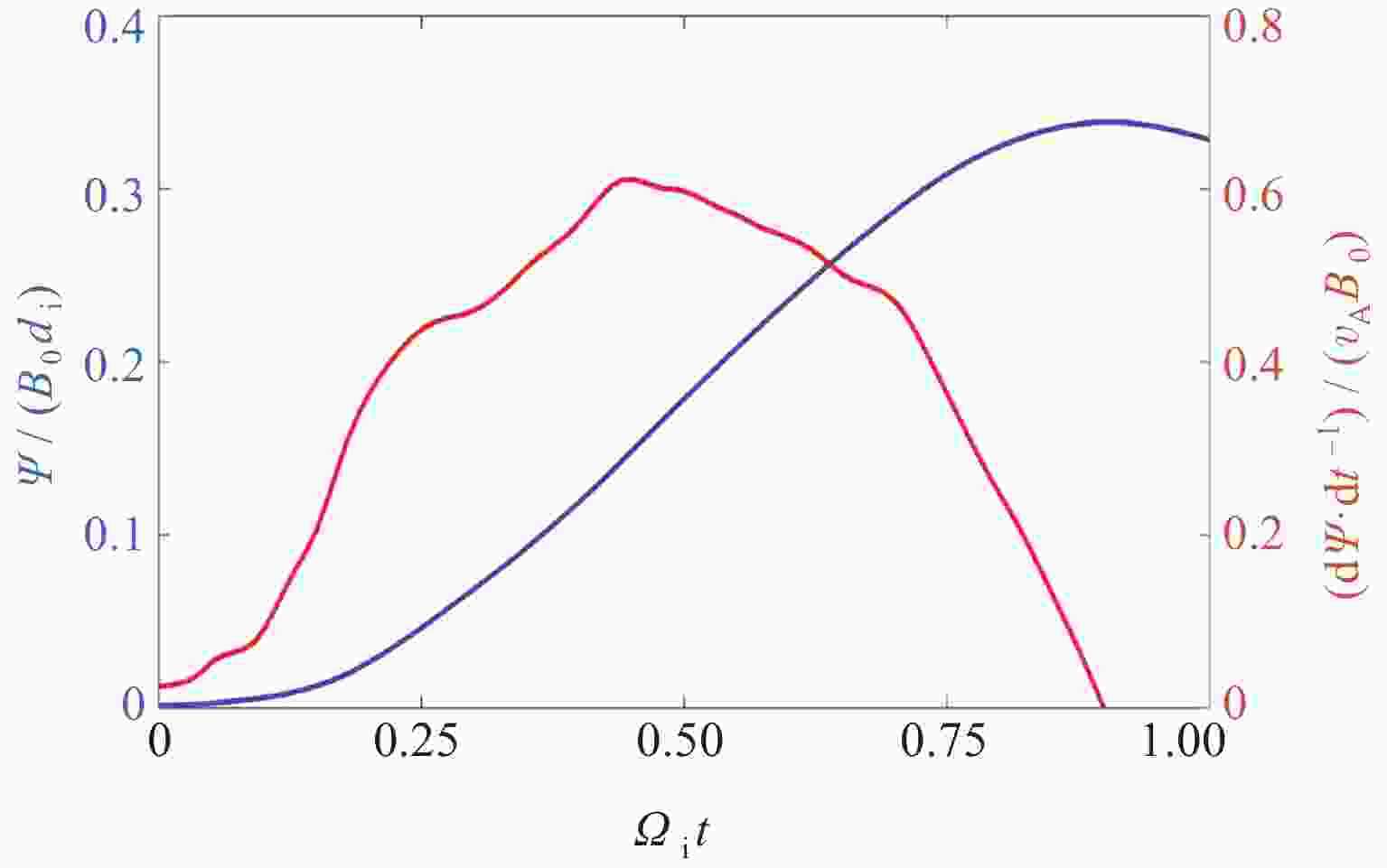
 下载:
下载:
